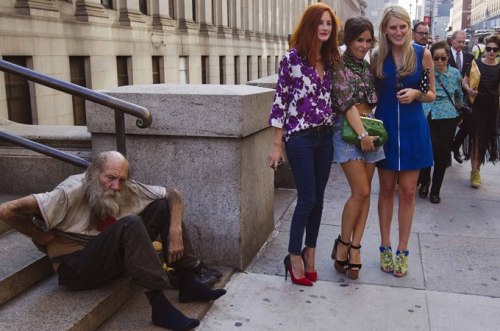Inequality: A Tale of Two One Percents,
The High and the Low
The High and the Low

A shorter, improved version of this essay was published at inequality (dot) org, and the long version at The Real News Network.
__________________________________________________
It is instructive to view the entire spectrum of wealth and income, between individuals and nations. About half of humanity live on less than $5 a day, according to the Pew Research Center. (Check References at the end of this article.) In the U.S. the average income per day per capita is $121, but half of the population have daily incomes below $60. The wealth disparities are much greater. It’s becoming quite obvious that our global and national societies experience extreme inequalities. On viewing the extremes the issue of moral unacceptability comes into focus along with the concern about social cohesion. Fairness is crucial to cohesion and well-being, we are moral beings. Extreme differences create a toxic atmosphere of distrust, and danger. I’ll try to explain conditions in the U.S. between the two extremes, the lower and upper one percents, and relate them to the medians and averages of wealth and income.
__________________________________________________
It is instructive to view the entire spectrum of wealth and income, between individuals and nations. About half of humanity live on less than $5 a day, according to the Pew Research Center. (Check References at the end of this article.) In the U.S. the average income per day per capita is $121, but half of the population have daily incomes below $60. The wealth disparities are much greater. It’s becoming quite obvious that our global and national societies experience extreme inequalities. On viewing the extremes the issue of moral unacceptability comes into focus along with the concern about social cohesion. Fairness is crucial to cohesion and well-being, we are moral beings. Extreme differences create a toxic atmosphere of distrust, and danger. I’ll try to explain conditions in the U.S. between the two extremes, the lower and upper one percents, and relate them to the medians and averages of wealth and income.
Wealth: $400,000 is approximately the average net worth of each adult citizen in the U.S.A. But “average” is very deceptive. Only about 12% of adults are “average” or above. The wealthiest 1% of households own 42.1% of all household net worth, states one report. The lower-saving half of households own only 1.1% of net worth, states another report. The difference in savings between a 1% household and a lower-half household is almost 2,000 times. The median adult owns $44,977, or 11% of the average, states the Credit Suisse Bank report, Global Wealth Report. The Federal Reserve’s report on household well-being says that 44% of adults surveyed cannot pay an emergency $400 expense within a 30 day period. No savings. Since 2009 total household net worth has increased by 71%, from a nominal $48.4 trillion to $94.8 trillion. In other words, since the financial sector self-destructed in 2008, throwing millions out of work and causing millions to lose their homes, the wealthiest have amassed 71% more in net worth. This economic model is now facing rejection from populations in the U.S. and in Europe.
Income: $90,000 is the average (again average) income per worker if we divide the national income with the number of workers in 2015. But only 56% of the yearly national income is derived from salary and wages. Workers of course earn “wage income”. The Social Security Administration report shows that the lower-earning half, or 80 million workers, had income below $30,000; their average income was under $13,000; and their collective wage income was less than 8% of total national income. But since workers are often married, and perhaps they receive pension income, Social Security and other incomes, collectively the lower 50% of tax filers receive 16% of all income, about a sixth of total income. The average annual income for 2.3 million adults in the top one percent is $1.3 million (and that doubles to $2.6 million in a married couple household). The yearly income for the lower 2.3 million adults: under $1,000 a year, $2 a day. One report shows that in the 35 years from 1980 to 2015, the income of the lower half of U.S. adults increased by 1%, and for the top 1% it has tripled, and the gap is 81 times. This is a profile of an economic model facing rejection.
A recent book, $2 a Day: Living on Almost Nothing in America, states, “the number of American families living on $2.00 per person, per day, has skyrocketed to one and a half million American households, including about three million children.” This is one percent of all households, the lower one percent. The authors published an article in Pathways, the magazine from Stanford University’s Center on Poverty and Inequality, and it states, “This figure shows that the number of households living on $2 or less in cash income per person per day in a given month increased from about 636,000 in 1996 to about 1.65 million in mid-2011 . . . In mid-2011 about 3.55 million children lived in extreme poverty in a given month.” The authors chose 1996 because it marks the date when "welfare as we know it" was dismantled. This resulted in creating perhaps 5 million citizens living in extreme poverty, cashless. The total in 2011 of 3.55 million extremely poor children is just under 5% of all children, one of every 20, a horrifying American distinction.
The Daily Incomes of American Income Stratas
A line-up of the spectrum of daily incomes shows the enormous range our society has created.
The top one percent earn far more than other earners.
1% at the top — $3,561 per day per adult, ($1.3 million
per year) and double if a married
couple
1% at the bottom — $2 a day, perhaps as high as $6 a
day with children
BEA average income — $184 a day per adult, derived from
BEA total income of $16.2 trillion
Median family income — $120 a day per adult in a typical four
annual income.
Median household income - $77 a day per adult
Median household income - $77 a day per adult
The median adult income is not a four person family, only 24% of the nation's households are four persons, five, six or more persons. Some 62% of households are 1 person and 2 person households (See the link, U.S. Census, hinc-01). The average household is comprised of 2.6 persons. The actual income per adult for the median household is $77 per day. Some 28% of households are single person, with a median daily income of $79, yearly median of $28,800. Another 34% are 2 person (mostly 2 adults in household, I presume) with median daily incomes of $87, and yearly median income of $63,850. I find this complex, reader. But above all, the average is about $180 per day per adult, using BEA figures.
Nonsupervisory employees -- $106 a day. $38,728 per year.
average About 80% of workers in this
category. Since 1980 this wage
income has increased by 5% while
per capita GDP has increased by
82%. See the very last reference.
Median cost of living — $87 a day per adult in a four person
average About 80% of workers in this
category. Since 1980 this wage
income has increased by 5% while
per capita GDP has increased by
82%. See the very last reference.
Median cost of living — $87 a day per adult in a four person
family living in the median cost
U.S. location, Des Moines, Iowa,
$31,755 annual income per adult
The median income is 31% above
median expenses, a good sign.
Official Poverty level — $34 a day per adult in a four person
household, under half the median
expenses. SPM records 14% of
U.S. population in poverty.
140% of poverty — $47 a day per adult in a four person
household, about 25% of the BEA
average adult income. In 2011
some 30% of Americans lived
below 140% of Poverty.
Poverty Measure, U.S. Census,
stated that this was insufficient to
achieve a “safe and decent”
standard of living.
We are not without solutions to inequality, but we are bereft of conversation, information and political will. We have abundant prosperity, it is time we shared it.
________________________________________________________________________________
References
$5 a day: "A Global Middle Class Is More Promise than Reality, Pew Research Center, chart “How Many Live on How Much”
average income is $121 a day: Congressional Joint Committee on Taxation, 2017, page 31. Divide total income by 325 million citizens and by 365 days.
$60 a day: $56,516, median household income, divided by 2.6 people, average household size, divided by 365.
$400,000: 237.9 million adults 20 years and above in 2017, see here, p. 37, adjust for 2017 population growth to 239 million, results in $396,600 average net worth per adult. $94.8 trillion private household net worth, see here, page 2, and 138. Number of U.S. households, here.
average income is $121 a day: Congressional Joint Committee on Taxation, 2017, page 31. Divide total income by 325 million citizens and by 365 days.
$60 a day: $56,516, median household income, divided by 2.6 people, average household size, divided by 365.
$400,000: 237.9 million adults 20 years and above in 2017, see here, p. 37, adjust for 2017 population growth to 239 million, results in $396,600 average net worth per adult. $94.8 trillion private household net worth, see here, page 2, and 138. Number of U.S. households, here.
12% of adults: see U.S. Census here, Table 4. And see Net Worth percentile calculator
42.1% of all savings: see here, page 39
1.1% of all savings: see Economic Policy Institute
2,000 times: see Credit Suisse Bank, Databook, Table 2-4, 6-5
Credit Suisse Bank: see here, Table 6-1, 6-5, 6-6.
44% of adults: see here, page 26
71% increase — Federal Reserve, Flow of Funds, 2009, Q4, Table B.101, and Flow of Funds, 2017, Q1, Table B.101.e, adjust the 2008 figures for inflation at BLS inflation calculator.
$16,000 per adult, Credit Suisse, Table 6-5, page 148
$90,000 is the average: see here, page 31
$56% of annual income: see here, Table 2.4
$1.3 million, see here p. 37
1% at Top - $3,561 -- same as $400,000 and $1.3 million above
Median family income, $94 - see here - U.S. Census, HINC -01. This is for all families, and for a four person family, the median is $87,739, U.S. Census. Daily income per adult is $120.
is $63,741 in Des Moines, Iowa.
BEA average, $156 - see BEA.gov, Table 2.1, "disposable income
per capita", meaning after federal taxes income.
$106 per day - see Bureau of Labor Statistics, and St. Louis Fed
and see Measuring Worth and the BLS inflation
calculator
and see Measuring Worth and the BLS inflation
calculator
Kathleen Short -- from the U.S. Census, November 2013, see here
p.23
Pew Research posted a report stating that 56% of Americans have incomes exceeding $50 a day, see here. Only 7% of humans enjoy this high income. See the BLS data on median and average incomes. BLS "average hourly and weekly earnings of production and nonsupervisory workers" from the BLS here: $747 a week, and $38,688 a year. This is the source of my $106 a day figure. The BLS reports median earnings for 110.7 million full-time workers, 72% of the workers, was $865 a week, $44,900 a year. Some 12% of workers work full-time but less than year-round (less than 50 weeks a year). Median is higher than average by 16%, indicating a large core of low-income workers.
The SSA wage report shows only 34% earning over $45,000, and that is 55 million workers, half of the 110 million who work full-time. The two reports coincide or match.
Dan Alpert at Economonitor describes this bifurcation of worker incomes, in a 2013 article, where 33% earn $15.38 an hour on average, and 67% earn $27.34 an hour. That averages to $23.54 an hour in 2013 in Alpert's report, which is considerably higher than the BLS 2017 report stating $22.10 an hour, for reasons I do not understand. The nature of the large lower-paid section is clear, and Alpert's and the BLS match if they are not the same exactly.
This indicates that raising the minimum wage (along with a hike in the EITC) would go a long ways to improving the living conditions for those low paid workers. In previous articles here -- see this article, the very end part -- I've often used the info from the EPI.org site, What Should You Be Earning? "if wages had kept pace with productivity". For instance in 2015, the SSA wage report shows, 48 million workers, or 30% of all workers, were surviving on less than $15,000 a year. They would be earning $26,768 a year and less -- that's a 78% boost in income -- if wages and productivity had matched in the last 30 years, and they DID match between 1946 and 1976. Why not now? With $94 trillion in private savings, about $400,000 per adult, one would easily conclude that taxing a fraction of that would be sufficient to fund the jobs programs and the wage and EITC increases that I prescribe.
_________________________________________________________________________________
The chief author of the U.S. Census report, the Supplemental Poverty Measure, Kathleen Short, has written that the poverty level is about double the official rate: “The overall [SPM] poverty rate using the updated modified family budget thresholds [140% of poverty] was 30.0 percent, about 13.9 percentage points higher than the 16.1 percent SPM rate. . . . approximately 140 percent of the SPM threshold, rather than 200 percent, may be characterized as not able to meet their basic needs and achieve a safe and decent standard of living, or as families with ‘low income’.” The key fact here is that the author of the SPM is saying poverty stands at 30%. Not the SPM rate of 16.1%, or the Official rate of 15.1% in 2011.


A List of Needed Reforms
I'm adding a short list of some of the changes and solutions needed. Elect a Congress that will
1) eliminate private money from all public elections,
2) restore the right of workers to form unions and to strike without fear of losing their jobs,
3) provide tax incentives to corporations to pay higher wages to employees,
4) create public jobs and government subsidized private employment in order to tighten the job market and raise the norm for wage income. About 20 million workers are without full-time year-round employment, and another 17 million are earning below poverty on full-time jobs. Combined, that affects 22% of the U.S. workforce, almost 1 of every 4 workers.
5) mandate paid vacation and holidays comparable to the European Union standard,
6) provide childcare subsidies for low-income mothers with children,
7) raise the Earned Income Tax Credit,
8) increase public housing funding.
This will put the “demos” back in democracy and the economy. The nation can afford all these changes, we have a savings of nearly $100 Trillion. We have abundant prosperity, it is time we shared it.
See the web page for $2 a Day: Living on Almost Nothing in America.
Bernie Sanders gave a speech on poverty in May of 2016, see here, and read his list of improvements.
Bernie Sanders gave a speech on poverty in May of 2016, see here, and read his list of improvements.
An Odd Coincidence:
If all 80,397,000 workers in the lower-earning half of U.S. workers earned $7.25 an hour, the minimum wage, and worked the average number of hours per week, 34.5 hours, and worked full-time and year-round, 1,716 hours, their average yearly income would be $13,006. This would be $220 higher than their actual average income of $12,786. We are a minimum wage nation, at least half of us. Half do not work at minimum wage and full-time year-round, rather that half includes most part-time and partial year workers. 68% of all workers are full-time and year-round, 12% partial year, and 20% part-time. (See U.S. Census, here) (And see the related note in the References section.)
If all 80,397,000 workers in the lower-earning half of U.S. workers earned $7.25 an hour, the minimum wage, and worked the average number of hours per week, 34.5 hours, and worked full-time and year-round, 1,716 hours, their average yearly income would be $13,006. This would be $220 higher than their actual average income of $12,786. We are a minimum wage nation, at least half of us. Half do not work at minimum wage and full-time year-round, rather that half includes most part-time and partial year workers. 68% of all workers are full-time and year-round, 12% partial year, and 20% part-time. (See U.S. Census, here) (And see the related note in the References section.)
Another odd coincidence: The SSA report states 44% of workers earned less than $25,000 in 2015. I found that 41% of workers fall into 3 categories. Adding the 1) "augmented" unemployed (12%) with 2) the group working full-time but less than 50 weeks (12%) (see USCensus here), and 3) those who are working full-time year-round with income below the poverty level of $24,250 for a four-person family (17%); the total is 41% of an augmented work force.
UnemploymentThe essay by L. Randall Wray, "Full Employment: Are We There Yet?", page 7, at the Levy Economics Institute, Feb. 2017, provides the "augmented" unemployment figure of 12%. He states that about 20million workers are "at least partially idled" in 2017; I added his figures and got 18.8 million. The National Jobs for All Coalition has similar figures, see here. My conclusion: Many of those whose incomes fall below $25,000 (44% in the SSA report), are those who are 1) unemployed (augmented including part-time involuntarily workers and discouraged workers), or 2) working partial year, or 3) full-time year-round at low wages. This group comprises 67 million workers, and their collective income is less than 7% of national income. And by the way, we are not at Full Employment argues professor Wray, far from it. He promotes a permanent government job program, an "employer of last resort" policy. An excellent paper cogently argued.
And if you prefer radical departure from capitalism to a democratically inspired system: UnemploymentThe essay by L. Randall Wray, "Full Employment: Are We There Yet?", page 7, at the Levy Economics Institute, Feb. 2017, provides the "augmented" unemployment figure of 12%. He states that about 20million workers are "at least partially idled" in 2017; I added his figures and got 18.8 million. The National Jobs for All Coalition has similar figures, see here. My conclusion: Many of those whose incomes fall below $25,000 (44% in the SSA report), are those who are 1) unemployed (augmented including part-time involuntarily workers and discouraged workers), or 2) working partial year, or 3) full-time year-round at low wages. This group comprises 67 million workers, and their collective income is less than 7% of national income. And by the way, we are not at Full Employment argues professor Wray, far from it. He promotes a permanent government job program, an "employer of last resort" policy. An excellent paper cogently argued.
Participatiory Economics
Robin Hahnel's essay on "Participatory Economics and the Next System", here, at Z Communications explains an economy owned by the workers and consumers. The corporation is eliminated and replaced by "social ownership of the productive “commons,” democratic worker councils and federations, neighborhood consumer councils and federations, and a very carefully constructed procedure we call participatory planning that these councils and federations use to coordinate, or plan, their interrelated activities themselves." There is an alternative to capitalism as we know it. Like universal health care replacing the current for profit model, this change will require a revolution. I wrote an essay at this blog about Hahnel's book Economic Justice and Democracy, see here. That was 9 years ago.
The adult income (if a two adult family) would be $38 a day, just above the $34 a day of official poverty.
The adult income (if a two adult family) would be $38 a day, just above the $34 a day of official poverty.













